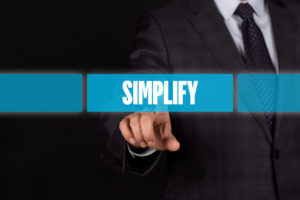
Communicating when it’s complicated
Recently, a client said to me, “I love how you always advise clear and concise communication. It ensures our clients always understand our message.
“But what do I do when I need to communicate something complicated? Worse, what do I do when I have to communicate, but I have conflicting viewpoints I need to convey?”
It’s no surprise that this question was spurred by the current COVID-19 crisis. With the continuing crisis and new information every day, organizations need to update employees and clients regularly.
During a crisis, it’s more important than ever to communicate clearly and consistently. Here are some tips that can help.
Communicating clearly with a one-page Message Map
There’s a reason I advise all of my clients to create one-page Message Maps: They work.
When you have all the relevant information on one page, you (and everyone else in your organization) can communicate clearly, concisely and consistently.
Message Maps aren’t just for your company or product message. They also work well during a crisis or complicated situation.
Here’s why: In addition to ensuring your message is clear, concise and consistent, Message Maps also help expose any holes in your story. They ensure you have the why, the “what’s in it for me?” for your audience, as well as reasons to believe that why.
Creating a Message Map forces you to keep asking “why” until you get the right answer – one that will tell your audience what’s in it for them.
Communicating too soon
Years ago I worked at a telecom company. One day I received a phone call from a reporter asking why our products were setting people’s homes on fire. The call took us by surprise, so we quickly gathered a crisis team to investigate the issue.
The engineering team assumed it was something faulty in the manufacturing, but they couldn’t tell us exactly what was wrong or how it could be fixed. Without that critical information, we couldn’t complete our Message Map or have a clear message to our customers and the reporters who kept calling.
I bought time with the media so we could get to the real root cause of the problem. And to this day, I’m so glad I did. It turned out that the product was fine. The company we contracted to install it had installed several of them incorrectly, causing the product to spark.
Many situations, especially crises, call for communicating as quickly as possible. And that’s exactly what you should do – but only when you’re sure that you have the right information to communicate.
Sometimes it’s okay to be lengthy
If you’ve worked with me or have read some of my previous blogs, you know I always advise that concise, simple messages work best.
However, there are three situations when it’s okay to be lengthy:
- When you tell a story. Stories are one of the best ways to share information because they enable readers and listeners to paint a picture in their minds. They make the information more relatable.
- When you need to present more than one point of view. Sometimes even experts don’t agree on the best thing to do in a given situation. Just look at the current COVID-19 crisis. So how do you provide the information people need? The Atlantic did a great job by publishing an article interviewing several experts and providing all of their answers. The article is long, but it gives readers enough information to make decisions for themselves.
- When you have a lot of information that your audience needs to know. I usually advise my clients to be as brief as possible. But sometimes, as in the case of many articles about COVID-19, there is a LOT of information to convey. If you’re in that type of situation, stay true to your Message Map. Though your communication may be lengthy, you can still keep it clear, consistent, and as concise as possible.

While sometimes your communications may run long, remember this tip: the longer the communication, the more important it is to keep it simple. Do everything you can to ensure your audience hears and understands your message.
Use visual aids and analogies
There’s a reason we see so many maps and graphs about the spread of COVID-19. People grasp large numbers much better visually.

When you need to communicate something that involves a lot of data, particularly numbers, consider creating a graph, infographic, or other visual aid to help your audience grasp your message.
Analogies are another great way to communicate large numbers and other complicated information. When Apple launched the second-generation iPod, Steve Jobs said, “iPod lets you easily put your entire music collection in your pocket and listen to it anywhere. With the new 10GB iPod, you can listen to your music continuously on six round-trip flights between San Francisco and Tokyo and never hear the same song twice.”
Jobs easily could have just stated the number of songs the iPod holds, but instead he offered an analogy that make it real for people. Six international round-trip flights is time to hear a lot of music.
Tailor your communications to the medium
Because of COVID-19, many people who normally go to an office to work are now forced to work from home. As a result, more people are using videoconferences in place of in-person meetings.
If you need to communicate complicated information via videoconference, make sure you speak slowly enough in case there is jitter on the line. Pause frequently to check in with your audience, especially if you are not able to see everyone on the call while you are speaking.
Need to coach your employees on how to communicate and present effectively via videoconference? We can help. Email us today.
The COVID-19 crisis has forced us all to change some behaviors. We’re communicating via video and phone more than ever. We have to update employees, colleagues, clients, and families with new information frequently.
And that information is often complicated. By making a Message Map and explaining things clearly and simply, you can successfully convey complicated information to get your story heard.
For more tips on communications and marketing, subscribe to our blog.
Related Posts
Marketers: Are you getting value out of your analytics?
The field of marketing analytics has been around for years, yet many marketers I speak with still feel they’re not getting the most out...
To break through, keep your message short and sweet
To hook your audience quickly, make your message short and sweet. That’s the key to a breakthrough message. Make your message quick Short marketing...
News media interview? Read these tips to be a great spokesperson.
Great news! Your company scored a news media interview, a great chance to get your company’s story heard. And they’ve chosen you as the...
Will we see a digital marketing backlash?
Remember when digital marketing was the future? Marketers scrambled to persuade their organizations to put more money into digital and less into print. Everything...





